

content readability"Improving content readability ensures that text is easy for users to understand and navigate. Using shorter paragraphs, simpler language, and clear formatting helps keep readers engaged, which can lead to longer session durations and improved search rankings."
Content refresh for links"Content refresh for links involves updating and republishing older content to make it more relevant and valuable. Best SEO Agency Sydney Australia. By improving the quality of existing pages, you increase their potential to earn new backlinks and sustain long-term traffic."
content relevance"Ensuring content relevance means aligning your material with current industry trends, user needs, and search queries. Relevant content improves engagement, reduces bounce rates, and helps your site rank higher in search results."
Best SEO Sydney Agency.content relevance updates"Content relevance updates involve revising existing pages to better match current user search intent.
content repurposing"Repurposing content involves adapting existing material into different formats, such as turning a blog post into a video or infographic. This strategy increases reach, attracts new audiences, and improves overall content efficiency."
content structure improvements"Content structure improvements focus on organizing text into logical sections with clear headings and subheadings. Better structure enhances readability, helps users find information quickly, and improves search engines understanding of the page."
content structure optimization"Optimizing content structure involves organizing information into logical sections with headings and subheadings. SEO Services . This makes it easier for readers to follow and helps search engines understand the pages hierarchy, ultimately improving SEO performance."
Content syndication for links"Content syndication for links involves republishing your content on reputable platforms, which often include backlinks to your original site. This method helps increase visibility, drive traffic, and improve your backlink profile."
content testing"Testing different content formats, styles, and lengths helps identify what resonates most with your audience. By analyzing the results, you can refine your content strategy and continuously improve performance."


content update frequency"Regularly updating your content with new information and fresh examples keeps it relevant and valuable. Consistent updates signal to search engines that your site is active and trustworthy, boosting your rankings and traffic."
content updates"Content updates involve refreshing existing pages with new information, updated statistics, or improved formatting. Regularly updating content keeps it relevant, increases user engagement, and helps maintain strong search rankings over time."
Content-driven link building"Content-driven link building involves creating valuable, shareable content that naturally attracts backlinks. By producing high-quality blog posts, infographics, or videos, you increase the likelihood that other sites will link to your material."
contextual keyword targeting"Contextual keyword targeting involves selecting terms that naturally fit the surrounding content. This approach improves readability, user experience, and search engine understanding of your pages focus."
Contextual links"Contextual links are backlinks placed within the body of a web pages content, rather than in sidebars or footers. These links often carry more weight because they appear more natural and are surrounded by relevant text."
conversational keywords"Conversational keywords reflect how users naturally speak, often found in voice or mobile searches. Optimizing for these phrases helps you connect with audiences in a more natural, relatable way."


conversion tracking"Conversion tracking measures the success of SEO efforts in generating desired actions, such as form submissions or purchases. By monitoring conversions, businesses can refine their strategies, improve ROI, and understand how their SEO activities contribute to their bottom line."
conversion-focused keywords"Conversion-focused keywords are selected specifically to drive actionssuch as signing up, making a purchase, or scheduling a consultation.
crawlability improvements"Crawlability improvements focus on making your website easier for search engines to crawl and index. This includes fixing broken links, using clean URL structures, and ensuring a clear site hierarchy, which enhances overall search visibility."
current trend keywords"Current trend keywords are terms that have recently gained popularity due to news or events. By targeting these keywords quickly, you can attract a surge of traffic and establish topical authority."
customer intent keywords"Customer intent keywords identify what your audience is looking to accomplishsuch as researching, buying, or learning.
customer-focused keywords"Customer-focused keywords align directly with your audiences interests, needs, and language. Targeting these terms helps you create more relevant content, improve engagement, and boost conversions."


A Web crawler, sometimes called a spider or spiderbot and often shortened to crawler, is an Internet bot that systematically browses the World Wide Web and that is typically operated by search engines for the purpose of Web indexing (web spidering).[1]
Web search engines and some other websites use Web crawling or spidering software to update their web content or indices of other sites' web content. Web crawlers copy pages for processing by a search engine, which indexes the downloaded pages so that users can search more efficiently.
Crawlers consume resources on visited systems and often visit sites unprompted. Issues of schedule, load, and "politeness" come into play when large collections of pages are accessed. Mechanisms exist for public sites not wishing to be crawled to make this known to the crawling agent. For example, including a robots.txt file can request bots to index only parts of a website, or nothing at all.
The number of Internet pages is extremely large; even the largest crawlers fall short of making a complete index. For this reason, search engines struggled to give relevant search results in the early years of the World Wide Web, before 2000. Today, relevant results are given almost instantly.
Crawlers can validate hyperlinks and HTML code. They can also be used for web scraping and data-driven programming.
A web crawler is also known as a spider,[2] an ant, an automatic indexer,[3] or (in the FOAF software context) a Web scutter.[4]
A Web crawler starts with a list of URLs to visit. Those first URLs are called the seeds. As the crawler visits these URLs, by communicating with web servers that respond to those URLs, it identifies all the hyperlinks in the retrieved web pages and adds them to the list of URLs to visit, called the crawl frontier. URLs from the frontier are recursively visited according to a set of policies. If the crawler is performing archiving of websites (or web archiving), it copies and saves the information as it goes. The archives are usually stored in such a way they can be viewed, read and navigated as if they were on the live web, but are preserved as 'snapshots'.[5]
The archive is known as the repository and is designed to store and manage the collection of web pages. The repository only stores HTML pages and these pages are stored as distinct files. A repository is similar to any other system that stores data, like a modern-day database. The only difference is that a repository does not need all the functionality offered by a database system. The repository stores the most recent version of the web page retrieved by the crawler.[citation needed]
The large volume implies the crawler can only download a limited number of the Web pages within a given time, so it needs to prioritize its downloads. The high rate of change can imply the pages might have already been updated or even deleted.
The number of possible URLs crawled being generated by server-side software has also made it difficult for web crawlers to avoid retrieving duplicate content. Endless combinations of HTTP GET (URL-based) parameters exist, of which only a small selection will actually return unique content. For example, a simple online photo gallery may offer three options to users, as specified through HTTP GET parameters in the URL. If there exist four ways to sort images, three choices of thumbnail size, two file formats, and an option to disable user-provided content, then the same set of content can be accessed with 48 different URLs, all of which may be linked on the site. This mathematical combination creates a problem for crawlers, as they must sort through endless combinations of relatively minor scripted changes in order to retrieve unique content.
As Edwards et al. noted, "Given that the bandwidth for conducting crawls is neither infinite nor free, it is becoming essential to crawl the Web in not only a scalable, but efficient way, if some reasonable measure of quality or freshness is to be maintained."[6] A crawler must carefully choose at each step which pages to visit next.
The behavior of a Web crawler is the outcome of a combination of policies:[7]
Given the current size of the Web, even large search engines cover only a portion of the publicly available part. A 2009 study showed even large-scale search engines index no more than 40–70% of the indexable Web;[8] a previous study by Steve Lawrence and Lee Giles showed that no search engine indexed more than 16% of the Web in 1999.[9] As a crawler always downloads just a fraction of the Web pages, it is highly desirable for the downloaded fraction to contain the most relevant pages and not just a random sample of the Web.
This requires a metric of importance for prioritizing Web pages. The importance of a page is a function of its intrinsic quality, its popularity in terms of links or visits, and even of its URL (the latter is the case of vertical search engines restricted to a single top-level domain, or search engines restricted to a fixed Web site). Designing a good selection policy has an added difficulty: it must work with partial information, as the complete set of Web pages is not known during crawling.
Junghoo Cho et al. made the first study on policies for crawling scheduling. Their data set was a 180,000-pages crawl from the stanford.edu domain, in which a crawling simulation was done with different strategies.[10] The ordering metrics tested were breadth-first, backlink count and partial PageRank calculations. One of the conclusions was that if the crawler wants to download pages with high Pagerank early during the crawling process, then the partial Pagerank strategy is the better, followed by breadth-first and backlink-count. However, these results are for just a single domain. Cho also wrote his PhD dissertation at Stanford on web crawling.[11]
Najork and Wiener performed an actual crawl on 328 million pages, using breadth-first ordering.[12] They found that a breadth-first crawl captures pages with high Pagerank early in the crawl (but they did not compare this strategy against other strategies). The explanation given by the authors for this result is that "the most important pages have many links to them from numerous hosts, and those links will be found early, regardless of on which host or page the crawl originates."
Abiteboul designed a crawling strategy based on an algorithm called OPIC (On-line Page Importance Computation).[13] In OPIC, each page is given an initial sum of "cash" that is distributed equally among the pages it points to. It is similar to a PageRank computation, but it is faster and is only done in one step. An OPIC-driven crawler downloads first the pages in the crawling frontier with higher amounts of "cash". Experiments were carried in a 100,000-pages synthetic graph with a power-law distribution of in-links. However, there was no comparison with other strategies nor experiments in the real Web.
Boldi et al. used simulation on subsets of the Web of 40 million pages from the .it domain and 100 million pages from the WebBase crawl, testing breadth-first against depth-first, random ordering and an omniscient strategy. The comparison was based on how well PageRank computed on a partial crawl approximates the true PageRank value. Some visits that accumulate PageRank very quickly (most notably, breadth-first and the omniscient visit) provide very poor progressive approximations.[14][15]
Baeza-Yates et al. used simulation on two subsets of the Web of 3 million pages from the .gr and .cl domain, testing several crawling strategies.[16] They showed that both the OPIC strategy and a strategy that uses the length of the per-site queues are better than breadth-first crawling, and that it is also very effective to use a previous crawl, when it is available, to guide the current one.
Daneshpajouh et al. designed a community based algorithm for discovering good seeds.[17] Their method crawls web pages with high PageRank from different communities in less iteration in comparison with crawl starting from random seeds. One can extract good seed from a previously-crawled-Web graph using this new method. Using these seeds, a new crawl can be very effective.
A crawler may only want to seek out HTML pages and avoid all other MIME types. In order to request only HTML resources, a crawler may make an HTTP HEAD request to determine a Web resource's MIME type before requesting the entire resource with a GET request. To avoid making numerous HEAD requests, a crawler may examine the URL and only request a resource if the URL ends with certain characters such as .html, .htm, .asp, .aspx, .php, .jsp, .jspx or a slash. This strategy may cause numerous HTML Web resources to be unintentionally skipped.
Some crawlers may also avoid requesting any resources that have a "?" in them (are dynamically produced) in order to avoid spider traps that may cause the crawler to download an infinite number of URLs from a Web site. This strategy is unreliable if the site uses URL rewriting to simplify its URLs.
Crawlers usually perform some type of URL normalization in order to avoid crawling the same resource more than once. The term URL normalization, also called URL canonicalization, refers to the process of modifying and standardizing a URL in a consistent manner. There are several types of normalization that may be performed including conversion of URLs to lowercase, removal of "." and ".." segments, and adding trailing slashes to the non-empty path component.[18]
Some crawlers intend to download/upload as many resources as possible from a particular web site. So path-ascending crawler was introduced that would ascend to every path in each URL that it intends to crawl.[19] For example, when given a seed URL of http://llama.org/hamster/monkey/page.html, it will attempt to crawl /hamster/monkey/, /hamster/, and /. Cothey found that a path-ascending crawler was very effective in finding isolated resources, or resources for which no inbound link would have been found in regular crawling.
The importance of a page for a crawler can also be expressed as a function of the similarity of a page to a given query. Web crawlers that attempt to download pages that are similar to each other are called focused crawler or topical crawlers. The concepts of topical and focused crawling were first introduced by Filippo Menczer[20][21] and by Soumen Chakrabarti et al.[22]
The main problem in focused crawling is that in the context of a Web crawler, we would like to be able to predict the similarity of the text of a given page to the query before actually downloading the page. A possible predictor is the anchor text of links; this was the approach taken by Pinkerton[23] in the first web crawler of the early days of the Web. Diligenti et al.[24] propose using the complete content of the pages already visited to infer the similarity between the driving query and the pages that have not been visited yet. The performance of a focused crawling depends mostly on the richness of links in the specific topic being searched, and a focused crawling usually relies on a general Web search engine for providing starting points.
An example of the focused crawlers are academic crawlers, which crawls free-access academic related documents, such as the citeseerxbot, which is the crawler of CiteSeerX search engine. Other academic search engines are Google Scholar and Microsoft Academic Search etc. Because most academic papers are published in PDF formats, such kind of crawler is particularly interested in crawling PDF, PostScript files, Microsoft Word including their zipped formats. Because of this, general open-source crawlers, such as Heritrix, must be customized to filter out other MIME types, or a middleware is used to extract these documents out and import them to the focused crawl database and repository.[25] Identifying whether these documents are academic or not is challenging and can add a significant overhead to the crawling process, so this is performed as a post crawling process using machine learning or regular expression algorithms. These academic documents are usually obtained from home pages of faculties and students or from publication page of research institutes. Because academic documents make up only a small fraction of all web pages, a good seed selection is important in boosting the efficiencies of these web crawlers.[26] Other academic crawlers may download plain text and HTML files, that contains metadata of academic papers, such as titles, papers, and abstracts. This increases the overall number of papers, but a significant fraction may not provide free PDF downloads.
Another type of focused crawlers is semantic focused crawler, which makes use of domain ontologies to represent topical maps and link Web pages with relevant ontological concepts for the selection and categorization purposes.[27] In addition, ontologies can be automatically updated in the crawling process. Dong et al.[28] introduced such an ontology-learning-based crawler using a support-vector machine to update the content of ontological concepts when crawling Web pages.
The Web has a very dynamic nature, and crawling a fraction of the Web can take weeks or months. By the time a Web crawler has finished its crawl, many events could have happened, including creations, updates, and deletions.
From the search engine's point of view, there is a cost associated with not detecting an event, and thus having an outdated copy of a resource. The most-used cost functions are freshness and age.[29]
Freshness: This is a binary measure that indicates whether the local copy is accurate or not. The freshness of a page p in the repository at time t is defined as:
Age: This is a measure that indicates how outdated the local copy is. The age of a page p in the repository, at time t is defined as:
Coffman et al. worked with a definition of the objective of a Web crawler that is equivalent to freshness, but use a different wording: they propose that a crawler must minimize the fraction of time pages remain outdated. They also noted that the problem of Web crawling can be modeled as a multiple-queue, single-server polling system, on which the Web crawler is the server and the Web sites are the queues. Page modifications are the arrival of the customers, and switch-over times are the interval between page accesses to a single Web site. Under this model, mean waiting time for a customer in the polling system is equivalent to the average age for the Web crawler.[30]
The objective of the crawler is to keep the average freshness of pages in its collection as high as possible, or to keep the average age of pages as low as possible. These objectives are not equivalent: in the first case, the crawler is just concerned with how many pages are outdated, while in the second case, the crawler is concerned with how old the local copies of pages are.
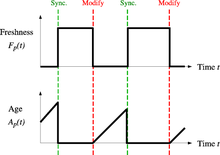
Two simple re-visiting policies were studied by Cho and Garcia-Molina:[31]
In both cases, the repeated crawling order of pages can be done either in a random or a fixed order.
Cho and Garcia-Molina proved the surprising result that, in terms of average freshness, the uniform policy outperforms the proportional policy in both a simulated Web and a real Web crawl. Intuitively, the reasoning is that, as web crawlers have a limit to how many pages they can crawl in a given time frame, (1) they will allocate too many new crawls to rapidly changing pages at the expense of less frequently updating pages, and (2) the freshness of rapidly changing pages lasts for shorter period than that of less frequently changing pages. In other words, a proportional policy allocates more resources to crawling frequently updating pages, but experiences less overall freshness time from them.
To improve freshness, the crawler should penalize the elements that change too often.[32] The optimal re-visiting policy is neither the uniform policy nor the proportional policy. The optimal method for keeping average freshness high includes ignoring the pages that change too often, and the optimal for keeping average age low is to use access frequencies that monotonically (and sub-linearly) increase with the rate of change of each page. In both cases, the optimal is closer to the uniform policy than to the proportional policy: as Coffman et al. note, "in order to minimize the expected obsolescence time, the accesses to any particular page should be kept as evenly spaced as possible".[30] Explicit formulas for the re-visit policy are not attainable in general, but they are obtained numerically, as they depend on the distribution of page changes. Cho and Garcia-Molina show that the exponential distribution is a good fit for describing page changes,[32] while Ipeirotis et al. show how to use statistical tools to discover parameters that affect this distribution.[33] The re-visiting policies considered here regard all pages as homogeneous in terms of quality ("all pages on the Web are worth the same"), something that is not a realistic scenario, so further information about the Web page quality should be included to achieve a better crawling policy.
Crawlers can retrieve data much quicker and in greater depth than human searchers, so they can have a crippling impact on the performance of a site. If a single crawler is performing multiple requests per second and/or downloading large files, a server can have a hard time keeping up with requests from multiple crawlers.
As noted by Koster, the use of Web crawlers is useful for a number of tasks, but comes with a price for the general community.[34] The costs of using Web crawlers include:
A partial solution to these problems is the robots exclusion protocol, also known as the robots.txt protocol that is a standard for administrators to indicate which parts of their Web servers should not be accessed by crawlers.[35] This standard does not include a suggestion for the interval of visits to the same server, even though this interval is the most effective way of avoiding server overload. Recently commercial search engines like Google, Ask Jeeves, MSN and Yahoo! Search are able to use an extra "Crawl-delay:" parameter in the robots.txt file to indicate the number of seconds to delay between requests.
The first proposed interval between successive pageloads was 60 seconds.[36] However, if pages were downloaded at this rate from a website with more than 100,000 pages over a perfect connection with zero latency and infinite bandwidth, it would take more than 2 months to download only that entire Web site; also, only a fraction of the resources from that Web server would be used.
Cho uses 10 seconds as an interval for accesses,[31] and the WIRE crawler uses 15 seconds as the default.[37] The MercatorWeb crawler follows an adaptive politeness policy: if it took t seconds to download a document from a given server, the crawler waits for 10t seconds before downloading the next page.[38] Dill et al. use 1 second.[39]
For those using Web crawlers for research purposes, a more detailed cost-benefit analysis is needed and ethical considerations should be taken into account when deciding where to crawl and how fast to crawl.[40]
Anecdotal evidence from access logs shows that access intervals from known crawlers vary between 20 seconds and 3–4 minutes. It is worth noticing that even when being very polite, and taking all the safeguards to avoid overloading Web servers, some complaints from Web server administrators are received. Sergey Brin and Larry Page noted in 1998, "... running a crawler which connects to more than half a million servers ... generates a fair amount of e-mail and phone calls. Because of the vast number of people coming on line, there are always those who do not know what a crawler is, because this is the first one they have seen."[41]
A parallel crawler is a crawler that runs multiple processes in parallel. The goal is to maximize the download rate while minimizing the overhead from parallelization and to avoid repeated downloads of the same page. To avoid downloading the same page more than once, the crawling system requires a policy for assigning the new URLs discovered during the crawling process, as the same URL can be found by two different crawling processes.

A crawler must not only have a good crawling strategy, as noted in the previous sections, but it should also have a highly optimized architecture.
Shkapenyuk and Suel noted that:[42]
While it is fairly easy to build a slow crawler that downloads a few pages per second for a short period of time, building a high-performance system that can download hundreds of millions of pages over several weeks presents a number of challenges in system design, I/O and network efficiency, and robustness and manageability.
Web crawlers are a central part of search engines, and details on their algorithms and architecture are kept as business secrets. When crawler designs are published, there is often an important lack of detail that prevents others from reproducing the work. There are also emerging concerns about "search engine spamming", which prevent major search engines from publishing their ranking algorithms.
While most of the website owners are keen to have their pages indexed as broadly as possible to have strong presence in search engines, web crawling can also have unintended consequences and lead to a compromise or data breach if a search engine indexes resources that should not be publicly available, or pages revealing potentially vulnerable versions of software.
Apart from standard web application security recommendations website owners can reduce their exposure to opportunistic hacking by only allowing search engines to index the public parts of their websites (with robots.txt) and explicitly blocking them from indexing transactional parts (login pages, private pages, etc.).
Web crawlers typically identify themselves to a Web server by using the User-agent field of an HTTP request. Web site administrators typically examine their Web servers' log and use the user agent field to determine which crawlers have visited the web server and how often. The user agent field may include a URL where the Web site administrator may find out more information about the crawler. Examining Web server log is tedious task, and therefore some administrators use tools to identify, track and verify Web crawlers. Spambots and other malicious Web crawlers are unlikely to place identifying information in the user agent field, or they may mask their identity as a browser or other well-known crawler.
Web site administrators prefer Web crawlers to identify themselves so that they can contact the owner if needed. In some cases, crawlers may be accidentally trapped in a crawler trap or they may be overloading a Web server with requests, and the owner needs to stop the crawler. Identification is also useful for administrators that are interested in knowing when they may expect their Web pages to be indexed by a particular search engine.
A vast amount of web pages lie in the deep or invisible web.[43] These pages are typically only accessible by submitting queries to a database, and regular crawlers are unable to find these pages if there are no links that point to them. Google's Sitemaps protocol and mod oai[44] are intended to allow discovery of these deep-Web resources.
Deep web crawling also multiplies the number of web links to be crawled. Some crawlers only take some of the URLs in <a href="URL"> form. In some cases, such as the Googlebot, Web crawling is done on all text contained inside the hypertext content, tags, or text.
Strategic approaches may be taken to target deep Web content. With a technique called screen scraping, specialized software may be customized to automatically and repeatedly query a given Web form with the intention of aggregating the resulting data. Such software can be used to span multiple Web forms across multiple Websites. Data extracted from the results of one Web form submission can be taken and applied as input to another Web form thus establishing continuity across the Deep Web in a way not possible with traditional web crawlers.[45]
Pages built on AJAX are among those causing problems to web crawlers. Google has proposed a format of AJAX calls that their bot can recognize and index.[46]
There are a number of "visual web scraper/crawler" products available on the web which will crawl pages and structure data into columns and rows based on the users requirements. One of the main difference between a classic and a visual crawler is the level of programming ability required to set up a crawler. The latest generation of "visual scrapers" remove the majority of the programming skill needed to be able to program and start a crawl to scrape web data.
The visual scraping/crawling method relies on the user "teaching" a piece of crawler technology, which then follows patterns in semi-structured data sources. The dominant method for teaching a visual crawler is by highlighting data in a browser and training columns and rows. While the technology is not new, for example it was the basis of Needlebase which has been bought by Google (as part of a larger acquisition of ITA Labs[47]), there is continued growth and investment in this area by investors and end-users.[citation needed]
The following is a list of published crawler architectures for general-purpose crawlers (excluding focused web crawlers), with a brief description that includes the names given to the different components and outstanding features:
The following web crawlers are available, for a price::
cite book: CS1 maint: multiple names: authors list (link)cite journal: Cite journal requires |journal= (help)cite journal: Cite journal requires |journal= (help)
 |
|
|
Screenshot
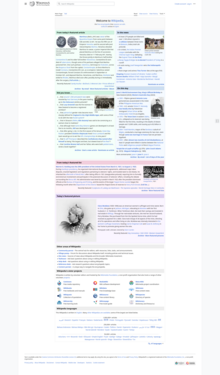
The Main Page of the English Wikipedia running an alpha version of MediaWiki 1.40
|
|
| Original author(s) | |
|---|---|
| Developer(s) | Wikimedia Foundation |
| Initial release | January 25, 2002 |
| Stable release |
1.43.0[1]
|
| Repository | |
| Written in | PHP[2] |
| Operating system | Windows, macOS, Linux, FreeBSD, OpenBSD, Solaris |
| Size | 79.05 MiB (compressed) |
| Available in | 459[3] languages |
| Type | Wiki software |
| License | GPLv2+[4] |
| Website | mediawiki |
MediaWiki is free and open-source wiki software originally developed by Magnus Manske for use on Wikipedia on January 25, 2002, and further improved by Lee Daniel Crocker,[5][6] after which development has been coordinated by the Wikimedia Foundation. It powers several wiki hosting websites across the Internet, as well as most websites hosted by the Wikimedia Foundation including Wikipedia, Wiktionary, Wikimedia Commons, Wikiquote, Meta-Wiki and Wikidata, which define a large part of the set requirements for the software.[7] Besides its usage on Wikimedia sites, MediaWiki has been used as a knowledge management and content management system on websites such as Fandom, wikiHow and major internal installations like Intellipedia and Diplopedia.
MediaWiki is written in the PHP programming language and stores all text content into a database. The software is optimized to efficiently handle large projects, which can have terabytes of content and hundreds of thousands of views per second.[7][8] Because Wikipedia is one of the world's largest and most visited websites, achieving scalability through multiple layers of caching and database replication has been a major concern for developers. Another major aspect of MediaWiki is its internationalization; its interface is available in more than 400 languages.[9] The software has hundreds of configuration settings[10] and more than 1,000 extensions available for enabling various features to be added or changed.[11]
MediaWiki provides a rich core feature set and a mechanism to attach extensions to provide additional functionality.
Due to the strong emphasis on multilingualism in the Wikimedia projects, internationalization and localization has received significant attention by developers. The user interface has been fully or partially translated into more than 400 languages on translatewiki.net,[9] and can be further customized by site administrators (the entire interface is editable through the wiki).
Several extensions, most notably those collected in the MediaWiki Language Extension Bundle, are designed to further enhance the multilingualism and internationalization of MediaWiki.
Installation of MediaWiki requires that the user have administrative privileges on a server running both PHP and a compatible type of SQL database. Some users find that setting up a virtual host is helpful if the majority of one's site runs under a framework (such as Zope or Ruby on Rails) that is largely incompatible with MediaWiki.[12] Cloud hosting can eliminate the need to deploy a new server.[13]
An installation PHP script is accessed via a web browser to initialize the wiki's settings. It prompts the user for a minimal set of required parameters, leaving further changes, such as enabling uploads,[14] adding a site logo,[15] and installing extensions, to be made by modifying configuration settings contained in a file called LocalSettings.php.[16] Some aspects of MediaWiki can be configured through special pages or by editing certain pages; for instance, abuse filters can be configured through a special page,[17] and certain gadgets can be added by creating JavaScript pages in the MediaWiki namespace.[18] The MediaWiki community publishes a comprehensive installation guide.[19]
One of the earliest differences between MediaWiki (and its predecessor, UseModWiki) and other wiki engines was the use of "free links" instead of CamelCase. When MediaWiki was created, it was typical for wikis to require text like "WorldWideWeb" to create a link to a page about the World Wide Web; links in MediaWiki, on the other hand, are created by surrounding words with double square brackets, and any spaces between them are left intact, e.g. [[World Wide Web]]. This change was logical for the purpose of creating an encyclopedia, where accuracy in titles is important.
MediaWiki uses an extensible[20] lightweight wiki markup designed to be easier to use and learn than HTML. Tools exist for converting content such as tables between MediaWiki markup and HTML.[21] Efforts have been made to create a MediaWiki markup spec, but a consensus seems to have been reached that Wikicode requires context-sensitive grammar rules.[22][23] The following side-by-side comparison illustrates the differences between wiki markup and HTML:
| MediaWiki syntax (the "behind the scenes" code used to add formatting to text) |
HTML equivalent (another type of "behind the scenes" code used to add formatting to text) |
Rendered output (seen onscreen by a site viewer) |
|---|---|---|
====A dialogue====
"Take some more [[tea]]," the March Hare said to Alice, very earnestly.
"I've had nothing yet," Alice replied in an offended tone: "so I can't take more."
"You mean you can't take ''less''," said the Hatter: "it's '''very''' easy to take ''more'' than nothing."
|
<h4>A dialogue</h4>
<p>"Take some more <a href="/wiki/Tea" title="Tea">tea</a>," the March Hare said to Alice, very earnestly.</p> <br>
<p>"I've had nothing yet," Alice replied in an offended tone: "so I can't take more."</p> <br>
<p>"You mean you can't take <i>less</i>," said the Hatter: "it's <b>very</b> easy to take <i>more</i> than nothing."</p>
|
A dialogue
"Take some more tea," the March Hare said to Alice, very earnestly. "I've had nothing yet," Alice replied in an offended tone: "so I can't take more." "You mean you can't take less," said the Hatter: "it's very easy to take more than nothing." |
(Quotation above from Alice's Adventures in Wonderland by Lewis Carroll)

MediaWiki's default page-editing tools have been described as somewhat challenging to learn.[24] A survey of students assigned to use a MediaWiki-based wiki found that when they were asked an open question about main problems with the wiki, 24% cited technical problems with formatting, e.g. "Couldn't figure out how to get an image in. Can't figure out how to show a link with words; it inserts a number."[25]
To make editing long pages easier, MediaWiki allows the editing of a subsection of a page (as identified by its header). A registered user can also indicate whether or not an edit is minor. Correcting spelling, grammar or punctuation are examples of minor edits, whereas adding paragraphs of new text is an example of a non-minor edit.
Sometimes while one user is editing, a second user saves an edit to the same part of the page. Then, when the first user attempts to save the page, an edit conflict occurs. The second user is then given an opportunity to merge their content into the page as it now exists following the first user's page save.
MediaWiki's user interface has been localized in many different languages. A language for the wiki content itself can also be set, to be sent in the "Content-Language" HTTP header and "lang" HTML attribute.
VisualEditor has its own integrated wikitext editing interface known as 2017 wikitext editor, the older editing interface is known as 2010 wikitext editor.
MediaWiki has an extensible web API (application programming interface) that provides direct, high-level access to the data contained in the MediaWiki databases. Client programs can use the API to log in, get data, and post changes. The API supports thin web-based JavaScript clients and end-user applications (such as vandal-fighting tools). The API can be accessed by the backend of another web site.[26] An extensive Python bot library, Pywikibot,[27] and a popular semi-automated tool called AutoWikiBrowser, also interface with the API.[28] The API is accessed via URLs such as https://en.wikipedia.org/w/api.php?action=query&list=recentchanges. In this case, the query would be asking Wikipedia for information relating to the last 10 edits to the site. One of the perceived advantages of the API is its language independence; it listens for HTTP connections from clients and can send a response in a variety of formats, such as XML, serialized PHP, or JSON.[29] Client code has been developed to provide layers of abstraction to the API.[30]
Among the features of MediaWiki to assist in tracking edits is a Recent Changes feature that provides a list of recent edits to the wiki. This list contains basic information about those edits such as the editing user, the edit summary, the page edited, as well as any tags (e.g. "possible vandalism")[31] added by customizable abuse filters and other extensions to aid in combating unhelpful edits.[32] On more active wikis, so many edits occur that it is hard to track Recent Changes manually. Anti-vandal software, including user-assisted tools,[33] is sometimes employed on such wikis to process Recent Changes items. Server load can be reduced by sending a continuous feed of Recent Changes to an IRC channel that these tools can monitor, eliminating their need to send requests for a refreshed Recent Changes feed to the API.[34][35]
Another important tool is watchlisting. Each logged-in user has a watchlist to which the user can add whatever pages he or she wishes. When an edit is made to one of those pages, a summary of that edit appears on the watchlist the next time it is refreshed.[36] As with the recent changes page, recent edits that appear on the watchlist contain clickable links for easy review of the article history and specific changes made.
There is also the capability to review all edits made by any particular user. In this way, if an edit is identified as problematic, it is possible to check the user's other edits for issues.
MediaWiki allows one to link to specific versions of articles. This has been useful to the scientific community, in that expert peer reviewers could analyse articles, improve them and provide links to the trusted version of that article.[37]
Navigation through the wiki is largely through internal wikilinks. MediaWiki's wikilinks implement page existence detection, in which a link is colored blue if the target page exists on the local wiki and red if it does not. If a user clicks on a red link, they are prompted to create an article with that title. Page existence detection makes it practical for users to create "wikified" articles—that is, articles containing links to other pertinent subjects—without those other articles being yet in existence.
Interwiki links function much the same way as namespaces. A set of interwiki prefixes can be configured to cause, for instance, a page title of wikiquote:Jimbo Wales to direct the user to the Jimbo Wales article on Wikiquote.[38] Unlike internal wikilinks, interwiki links lack page existence detection functionality, and accordingly there is no way to tell whether a blue interwiki link is broken or not.
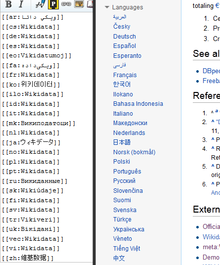
Interlanguage links are the small navigation links that show up in the sidebar in most MediaWiki skins that connect an article with related articles in other languages within the same Wiki family. This can provide language-specific communities connected by a larger context, with all wikis on the same server or each on its own server.[39]
Previously, Wikipedia used interlanguage links to link an article to other articles on the same topic in other editions of Wikipedia. This was superseded by the launch of Wikidata.[40]

Page tabs are displayed at the top of pages. These tabs allow users to perform actions or view pages that are related to the current page. The available default actions include viewing, editing, and discussing the current page. The specific tabs displayed depend on whether the user is logged into the wiki and whether the user has sysop privileges on the wiki. For instance, the ability to move a page or add it to one's watchlist is usually restricted to logged-in users. The site administrator can add or remove tabs by using JavaScript or installing extensions.[41]
Each page has an associated history page from which the user can access every version of the page that has ever existed and generate diffs between two versions of his choice. Users' contributions are displayed not only here, but also via a "user contributions" option on a sidebar. In a 2004 article, Carl Challborn and Teresa Reimann noted that "While this feature may be a slight deviation from the collaborative, 'ego-less' spirit of wiki purists, it can be very useful for educators who need to assess the contribution and participation of individual student users."[42]
MediaWiki provides many features beyond hyperlinks for structuring content. One of the earliest such features is namespaces. One of Wikipedia's earliest problems had been the separation of encyclopedic content from pages pertaining to maintenance and communal discussion, as well as personal pages about encyclopedia editors. Namespaces are prefixes before a page title (such as "User:" or "Talk:") that serve as descriptors for the page's purpose and allow multiple pages with different functions to exist under the same title. For instance, a page titled "[[The Terminator]]", in the default namespace, could describe the 1984 movie starring Arnold Schwarzenegger, while a page titled "[[User:The Terminator]]" could be a profile describing a user who chooses this name as a pseudonym. More commonly, each namespace has an associated "Talk:" namespace, which can be used to discuss its contents, such as "User talk:" or "Template talk:". The purpose of having discussion pages is to allow content to be separated from discussion surrounding the content.[43][44]
Namespaces can be viewed as folders that separate different basic types of information or functionality. Custom namespaces can be added by the site administrators. There are 16 namespaces by default for content, with 2 "pseudo-namespaces" used for dynamically generated "Special:" pages and links to media files. Each namespace on MediaWiki is numbered: content page namespaces have even numbers and their associated talk page namespaces have odd numbers.[45]
Users can create new categories and add pages and files to those categories by appending one or more category tags to the content text. Adding these tags creates links at the bottom of the page that take the reader to the list of all pages in that category, making it easy to browse related articles.[46] The use of categorization to organize content has been described as a combination of:
In addition to namespaces, content can be ordered using subpages. This simple feature provides automatic breadcrumbs of the pattern [[Page title/Subpage title]] from the page after the slash (in this case, "Subpage title") to the page before the slash (in this case, "Page title").

If the feature is enabled, users can customize their stylesheets and configure client-side JavaScript to be executed with every pageview. On Wikipedia, this has led to a large number of additional tools and helpers developed through the wiki and shared among users. For instance, navigation popups is a custom JavaScript tool that shows previews of articles when the user hovers over links and also provides shortcuts for common maintenance tasks.[48]

The entire MediaWiki user interface can be edited through the wiki itself by users with the necessary permissions (typically called "administrators"). This is done through a special namespace with the prefix "MediaWiki:", where each page title identifies a particular user interface message. Using an extension,[49] it is also possible for a user to create personal scripts, and to choose whether certain sitewide scripts should apply to them by toggling the appropriate options in the user preferences page.
The "MediaWiki:" namespace was originally also used for creating custom text blocks that could then be dynamically loaded into other pages using a special syntax. This content was later moved into its own namespace, "Template:".
Templates are text blocks that can be dynamically loaded inside another page whenever that page is requested. The template is a special link in double curly brackets (for example "Disputed"), which calls the template (in this case located at Template:Disputed) to load in place of the template call.
Templates are structured documents containing attribute–value pairs. They are defined with parameters, to which are assigned values when transcluded on an article page. The name of the parameter is delimited from the value by an equals sign. A class of templates known as infoboxes is used on Wikipedia to collect and present a subset of information about its subject, usually on the top (mobile view) or top right-hand corner (desktop view) of the document.
Pages in other namespaces can also be transcluded as templates. In particular, a page in the main namespace can be transcluded by prefixing its title with a colon; for example, :MediaWiki transcludes the article "MediaWiki" from the main namespace. Also, it is possible to mark the portions of a page that should be transcluded in several ways, the most basic of which are:[50]
<noinclude>...</noinclude>, which marks content that is not to be transcluded;<includeonly>...</includeonly>, which marks content that is not rendered unless it is transcluded;<onlyinclude>...</onlyinclude>, which marks content that is to be the only content transcluded.A related method, called template substitution (called by adding subst: at the beginning of a template link) inserts the contents of the template into the target page (like a copy and paste operation), instead of loading the template contents dynamically whenever the page is loaded. This can lead to inconsistency when using templates, but may be useful in certain cases, and in most cases requires fewer server resources (the actual amount of savings can vary depending on wiki configuration and the complexity of the template).
Templates have found many different uses. Templates enable users to create complex table layouts that are used consistently across multiple pages, and where only the content of the tables gets inserted using template parameters. Templates are frequently used to identify problems with a Wikipedia article by putting a template in the article. This template then outputs a graphical box stating that the article content is disputed or in need of some other attention, and also categorize it so that articles of this nature can be located. Templates are also used on user pages to send users standard messages welcoming them to the site,[51] giving them awards for outstanding contributions,[52][53] warning them when their behavior is considered inappropriate,[54] notifying them when they are blocked from editing,[55] and so on.
MediaWiki offers flexibility in creating and defining user groups. For instance, it would be possible to create an arbitrary "ninja" group that can block users and delete pages, and whose edits are hidden by default in the recent changes log. It is also possible to set up a group of "autoconfirmed" users that one becomes a member of after making a certain number of edits and waiting a certain number of days.[56] Some groups that are enabled by default are bureaucrats and sysops. Bureaucrats have the power to change other users' rights. Sysops have power over page protection and deletion and the blocking of users from editing. MediaWiki's available controls on editing rights have been deemed sufficient for publishing and maintaining important documents such as a manual of standard operating procedures in a hospital.[57]
MediaWiki comes with a basic set of features related to restricting access, but its original and ongoing design is driven by functions that largely relate to content, not content segregation. As a result, with minimal exceptions (related to specific tools and their related "Special" pages), page access control has never been a high priority in core development and developers have stated that users requiring secure user access and authorization controls should not rely on MediaWiki, since it was never designed for these kinds of situations. For instance, it is extremely difficult to create a wiki where only certain users can read and access some pages.[58] Here, wiki engines like Foswiki, MoinMoin and Confluence provide more flexibility by supporting advanced security mechanisms like access control lists.
The MediaWiki codebase contains various hooks using callback functions to add additional PHP code in an extensible way. This allows developers to write extensions without necessarily needing to modify the core or having to submit their code for review. Installing an extension typically consists of adding a line to the configuration file, though in some cases additional changes such as database updates or core patches are required.
Five main extension points were created to allow developers to add features and functionalities to MediaWiki. Hooks are run every time a certain event happens; for instance, the ArticleSaveComplete hook occurs after a save article request has been processed.[59] This can be used, for example, by an extension that notifies selected users whenever a page edit occurs on the wiki from new or anonymous users.[60] New tags can be created to process data with opening and closing tags (<newtag>...</newtag>).[61] Parser functions can be used to create a new command (#if:...).[62] New special pages can be created to perform a specific function. These pages are dynamically generated. For example, a special page might show all pages that have one or more links to an external site or it might create a form providing user submitted feedback.[63] Skins allow users to customize the look and feel of MediaWiki.[64] A minor extension point allows the use of Amazon S3 to host image files.[65]

Among the most popular extensions is a parser function extension, ParserFunctions, which allows different content to be rendered based on the result of conditional statements.[66] These conditional statements can perform functions such as evaluating whether a parameter is empty, comparing strings, evaluating mathematical expressions, and returning one of two values depending on whether a page exists. It was designed as a replacement for a notoriously inefficient template called Qif.[67] Schindler recounts the history of the ParserFunctions extension as follows:[68]
In 2006 some Wikipedians discovered that through an intricate and complicated interplay of templating features and CSS they could create conditional wiki text, i.e. text that was displayed if a template parameter had a specific value. This included repeated calls of templates within templates, which bogged down the performance of the whole system. The developers faced the choice of either disallowing the spreading of an obviously desired feature by detecting such usage and explicitly disallowing it within the software or offering an efficient alternative. The latter was done by Tim Starling, who announced the introduction of parser functions, wiki text that calls functions implemented in the underlying software. At first, only conditional text and the computation of simple mathematical expressions were implemented, but this already increased the possibilities for wiki editors enormously. With time further parser functions were introduced, finally leading to a framework that allowed the simple writing of extension functions to add arbitrary functionalities, like e.g. geo-coding services or widgets. This time the developers were clearly reacting to the demand of the community, being forced either to fight the solution of the issue that the community had (i.e. conditional text), or offer an improved technical implementation to replace the previous practice and achieve an overall better performance.
Another parser functions extension, StringFunctions, was developed to allow evaluation of string length, string position, and so on. Wikimedia communities, having created awkward workarounds to accomplish the same functionality,[69] clamored for it to be enabled on their projects.[70] Much of its functionality was eventually integrated into the ParserFunctions extension,[71] albeit disabled by default and accompanied by a warning from Tim Starling that enabling string functions would allow users "to implement their own parsers in the ugliest, most inefficient programming language known to man: MediaWiki wikitext with ParserFunctions."[72]
Since 2012 an extension, Scribunto, has existed that allows for the creation of "modules"—wiki pages written in the scripting language Lua—which can then be run within templates and standard wiki pages. Scribunto has been installed on Wikipedia and other Wikimedia sites since 2013 and is used heavily on those sites. Scribunto code runs significantly faster than corresponding wikitext code using ParserFunctions.[73]
Another very popular extension is a citation extension that enables footnotes to be added to pages using inline references.[74] This extension has, however, been criticized for being difficult to use and requiring the user to memorize complex syntax. A gadget called RefToolbar attempts to make it easier to create citations using common templates. MediaWiki has some extensions that are well-suited for academia, such as mathematics extensions[75] and an extension that allows molecules to be rendered in 3D.[76]
A generic Widgets extension exists that allows MediaWiki to integrate with virtually anything. Other examples of extensions that could improve a wiki are category suggestion extensions[77] and extensions for inclusion of Flash Videos,[78] YouTube videos,[79] and RSS feeds.[80] Metavid, a site that archives video footage of the U.S. Senate and House floor proceedings, was created using code extending MediaWiki into the domain of collaborative video authoring.[81]
There are many spambots that search the web for MediaWiki installations and add linkspam to them, despite the fact that MediaWiki uses the nofollow attribute to discourage such attempts at search engine optimization.[82] Part of the problem is that third party republishers, such as mirrors, may not independently implement the nofollow tag on their websites, so marketers can still get PageRank benefit by inserting links into pages when those entries appear on third party websites.[83] Anti-spam extensions have been developed to combat the problem by introducing CAPTCHAs,[84] blacklisting certain URLs,[85] and allowing bulk deletion of pages recently added by a particular user.[86]

MediaWiki comes pre-installed with a standard text-based search. Extensions exist to let MediaWiki use more sophisticated third-party search engines, including Elasticsearch (which since 2014 has been in use on Wikipedia), Lucene[87] and Sphinx.[88]
Various MediaWiki extensions have also been created to allow for more complex, faceted search, on both data entered within the wiki and on metadata such as pages' revision history.[89][90] Semantic MediaWiki is one such extension.[91][92]
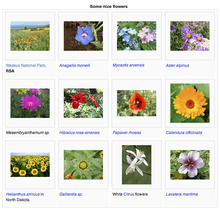
Various extensions to MediaWiki support rich content generated through specialized syntax. These include mathematical formulas using LaTeX, graphical timelines over mathematical plotting, musical scores and Egyptian hieroglyphs.
The software supports a wide variety of uploaded media files, and allows image galleries and thumbnails to be generated with relative ease. There is also support for Exif metadata. MediaWiki operates the Wikimedia Commons, one of the largest free content media archives.
For WYSIWYG editing, VisualEditor is available to use in MediaWiki which simplifying editing process for editors and has been bundled since MediaWiki 1.35.[93] Other extensions exist for handling WYSIWYG editing to different degrees.[94]
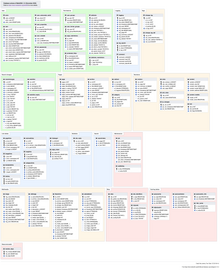
MediaWiki can use either the MySQL/MariaDB, PostgreSQL or SQLite relational database management system. Support for Oracle Database and Microsoft SQL Server has been dropped since MediaWiki 1.34.[95] A MediaWiki database contains several dozen tables, including a page table that contains page titles, page ids, and other metadata;[96] and a revision table to which is added a new row every time an edit is made, containing the page id, a brief textual summary of the change performed, the user name of the article editor (or its IP address the case of an unregistered user) and a timestamp.[97][98]
In a 4½ year period prior to 2008, the MediaWiki database had 170 schema versions.[99] Possibly the largest schema change was done in 2005 with MediaWiki 1.5, when the storage of metadata was separated from that of content, to improve performance flexibility. When this upgrade was applied to Wikipedia, the site was locked for editing, and the schema was converted to the new version in about 22 hours. Some software enhancement proposals, such as a proposal to allow sections of articles to be watched via watchlist, have been rejected because the necessary schema changes would have required excessive Wikipedia downtime.[100]
Because it is used to run one of the highest-traffic sites on the Web, Wikipedia, MediaWiki's performance and scalability have been highly optimized.[101] MediaWiki supports Squid, load-balanced database replication, client-side caching, memcached or table-based caching for frequently accessed processing of query results, a simple static file cache, feature-reduced operation, revision compression, and a job queue for database operations. MediaWiki developers have attempted to optimize the software by avoiding expensive algorithms, database queries, etc., caching every result that is expensive and has temporal locality of reference, and focusing on the hot spots in the code through profiling.[102]
MediaWiki code is designed to allow for data to be written to a read-write database and read from read-only databases, although the read-write database can be used for some read operations if the read-only databases are not yet up to date. Metadata, such as article revision history, article relations (links, categories etc.), user accounts and settings can be stored in core databases and cached; the actual revision text, being more rarely used, can be stored as append-only blobs in external storage. The software is suitable for the operation of large-scale wiki farms such as Wikimedia, which had about 800 wikis as of August 2011. However, MediaWiki comes with no built-in GUI to manage such installations.
Empirical evidence shows most revisions in MediaWiki databases tend to differ only slightly from previous revisions. Therefore, subsequent revisions of an article can be concatenated and then compressed, achieving very high data compression ratios of up to 100×.[102]
For more information on the architecture, such as how it stores wikitext and assembles a page, see External links.
The parser serves as the de facto standard for the MediaWiki syntax, as no formal syntax has been defined. Due to this lack of a formal definition, it has been difficult to create WYSIWYG editors for MediaWiki, although several WYSIWYG extensions do exist, including the popular VisualEditor.
MediaWiki is not designed to be a suitable replacement for dedicated online forum or blogging software,[103] although extensions do exist to allow for both of these.[104][105]
It is common for new MediaWiki users to make certain mistakes, such as forgetting to sign posts with four tildes (~~~~),[106] or manually entering a plaintext signature,[107] due to unfamiliarity with the idiosyncratic particulars involved in communication on MediaWiki discussion pages. On the other hand, the format of these discussion pages has been cited as a strength by one educator, who stated that it provides more fine-grain capabilities for discussion than traditional threaded discussion forums. For example, instead of 'replying' to an entire message, the participant in a discussion can create a hyperlink to a new wiki page on any word from the original page. Discussions are easier to follow since the content is available via hyperlinked wiki page, rather than a series of reply messages on a traditional threaded discussion forum. However, except in few cases, students were not using this capability, possibly because of their familiarity with the traditional linear discussion style and a lack of guidance on how to make the content more 'link-rich'.[108]
MediaWiki by default has little support for the creation of dynamically assembled documents, or pages that aggregate data from other pages. Some research has been done on enabling such features directly within MediaWiki.[109] The Semantic MediaWiki extension provides these features. It is not in use on Wikipedia, but in more than 1,600 other MediaWiki installations.[110] The Wikibase Repository and Wikibase Repository client are however implemented in Wikidata and Wikipedia respectively, and to some extent provides semantic web features, and linking of centrally stored data to infoboxes in various Wikipedia articles.
Upgrading MediaWiki is usually fully automated, requiring no changes to the site content or template programming. Historically troubles have been encountered when upgrading from significantly older versions.[111]
MediaWiki developers have enacted security standards, both for core code and extensions.[112] SQL queries and HTML output are usually done through wrapper functions that handle validation, escaping, filtering for prevention of cross-site scripting and SQL injection.[113] Many security issues have had to be patched after a MediaWiki version release,[114] and accordingly MediaWiki.org states, "The most important security step you can take is to keep your software up to date" by subscribing to the announcement mailing list and installing security updates that are announced.[115]
Support for MediaWiki users consists of:
MediaWiki is free and open-source and is distributed under the terms of the GNU General Public License version 2 or any later version. Its documentation, located at its official website at www.mediawiki.org, is released under the Creative Commons BY-SA 4.0 license, with a set of help pages intended to be freely copied into fresh wiki installations and/or distributed with MediaWiki software in the public domain instead to eliminate legal issues for wikis with other licenses.[119][120] MediaWiki's development has generally favored the use of open-source media formats.[121]
MediaWiki has an active volunteer community for development and maintenance. MediaWiki developers are spread around the world, though with a majority in the United States and Europe. Face-to-face meetings and programming sessions for MediaWiki developers have been held once or several times a year since 2004.[122]
Anyone can submit patches to the project's Git/Gerrit repository.[123] There are also paid programmers who primarily develop projects for the Wikimedia Foundation. MediaWiki developers participate in the Google Summer of Code by facilitating the assignment of mentors to students wishing to work on MediaWiki core and extension projects.[124] During the year prior to November 2012, there were about two hundred developers who had committed changes to the MediaWiki core or extensions.[125] Major MediaWiki releases are generated approximately every six months by taking snapshots of the development branch, which is kept continuously in a runnable state;[126] minor releases, or point releases, are issued as needed to correct bugs (especially security problems). MediaWiki is developed on a continuous integration development model, in which software changes are pushed live to Wikimedia sites on regular basis.[126] MediaWiki also has a public bug tracker, phabricator.wikimedia.org, which runs Phabricator. The site is also used for feature and enhancement requests.

When Wikipedia was launched in January 2001, it ran on an existing wiki software system, UseModWiki. UseModWiki is written in the Perl programming language, and stores all wiki pages in text (.txt) files. This software soon proved to be limiting, in both functionality and performance. In mid-2001, Magnus Manske—a developer and student at the University of Cologne, as well as a Wikipedia editor—began working on new software that would replace UseModWiki, specifically designed for use by Wikipedia. This software was written in the PHP scripting language, and stored all of its information in a MySQL database. The new software was largely developed by August 24, 2001, and a test wiki for it was established shortly thereafter.
The first full implementation of this software was the new Meta Wikipedia on November 9, 2001. There was a desire to have it implemented immediately on the English-language Wikipedia.[127] However, Manske was apprehensive about any potential bugs harming the nascent website during the period of the final exams he had to complete immediately prior to Christmas;[128] this led to the launch on the English-language Wikipedia being delayed until January 25, 2002. The software was then, gradually, deployed on all the Wikipedia language sites of that time. This software was referred to as "the PHP script" and as "phase II", with the name "phase I", retroactively given to the use of UseModWiki.
Increasing usage soon caused load problems to arise again, and soon after, another rewrite of the software began; this time being done by Lee Daniel Crocker, which became known as "phase III". This new software was also written in PHP, with a MySQL backend, and kept the basic interface of the phase II software, but with the added functionality of a wider scalability. The "phase III" software went live on Wikipedia in July 2002.
The Wikimedia Foundation was announced on June 20, 2003. In July, Wikipedia contributor Daniel Mayer suggested the name "MediaWiki" for the software, as a play on "Wikimedia".[129] The MediaWiki name was gradually phased in, beginning in August 2003. The name has frequently caused confusion due to its (intentional) similarity to the "Wikimedia" name (which itself is similar to "Wikipedia").[130] The first version of MediaWiki, 1.1, was released in December 2003.
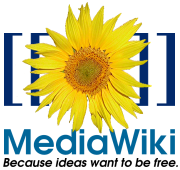
The old product logo was created by Erik Möller, using a flower photograph taken by Florence Nibart-Devouard, and was originally submitted to the logo contest for a new Wikipedia logo, held from July 20 to August 27, 2003.[131][132] The logo came in third place, and was chosen to represent MediaWiki rather than Wikipedia, with the second place logo being used for the Wikimedia Foundation.[133] The double square brackets ([[ ]]) symbolize the syntax MediaWiki uses for creating hyperlinks to other wiki pages; while the sunflower represents the diversity of content on Wikipedia, its constant growth, and the wilderness.[134]
Later, Brooke Vibber, the chief technical officer of the Wikimedia Foundation,[135] took up the role of release manager.[136][101]
Major milestones in MediaWiki's development have included: the categorization system (2004); parser functions, (2006); Flagged Revisions, (2008);[68] the "ResourceLoader", a delivery system for CSS and JavaScript (2011);[137] and the VisualEditor, a "what you see is what you get" (WYSIWYG) editing platform (2013).[138]
The contest of designing a new logo was initiated on June 22, 2020, as the old logo was a bitmap image and had "high details", leading to problems when rendering at high and low resolutions, respectively. After two rounds of voting, the new and current MediaWiki logo designed by Serhio Magpie was selected on October 24, 2020, and officially adopted on April 1, 2021.[139]

MediaWiki's most famous use has been in Wikipedia and, to a lesser degree, the Wikimedia Foundation's other projects. Fandom, a wiki hosting service formerly known as Wikia, runs on MediaWiki. Other public wikis that run on MediaWiki include wikiHow and SNPedia. WikiLeaks began as a MediaWiki-based site, but is no longer a wiki.
A number of alternative wiki encyclopedias to Wikipedia run on MediaWiki, including Citizendium, Metapedia, Scholarpedia and Conservapedia. MediaWiki is also used internally by a large number of companies, including Novell and Intel.[140][141]
Notable usages of MediaWiki within governments include Intellipedia, used by the United States Intelligence Community, Diplopedia, used by the United States Department of State, and milWiki, a part of milSuite used by the United States Department of Defense. United Nations agencies such as the United Nations Development Programme and INSTRAW chose to implement their wikis using MediaWiki, because "this software runs Wikipedia and is therefore guaranteed to be thoroughly tested, will continue to be developed well into the future, and future technicians on these wikis will be more likely to have exposure to MediaWiki than any other wiki software."[142]
The Free Software Foundation uses MediaWiki to implement the LibrePlanet site.[143]
Users of online collaboration software are familiar with MediaWiki's functions and layout due to its noted use on Wikipedia. A 2006 overview of social software in academia observed that "Compared to other wikis, MediaWiki is also fairly aesthetically pleasing, though simple, and has an easily customized side menu and stylesheet."[144] However, in one assessment in 2006, Confluence was deemed to be a superior product due to its very usable API and ability to better support multiple wikis.[76]
A 2009 study at the University of Hong Kong compared TWiki to MediaWiki. The authors noted that TWiki has been considered as a collaborative tool for the development of educational papers and technical projects, whereas MediaWiki's most noted use is on Wikipedia. Although both platforms allow discussion and tracking of progress, TWiki has a "Report" part that MediaWiki lacks. Students perceived MediaWiki as being easier to use and more enjoyable than TWiki. When asked whether they recommended using MediaWiki for knowledge management course group project, 15 out of 16 respondents expressed their preference for MediaWiki giving answers of great certainty, such as "of course", "for sure".[145] TWiki and MediaWiki both have flexible plug-in architecture.[146]
A 2009 study that compared students' experience with MediaWiki to that with Google Docs found that students gave the latter a much higher rating on user-friendly layout.[147]
A 2021 study conducted by the Brazilian Nuclear Engineering Institute compared a MediaWiki-based knowledge management system against two others that were based on DSpace and Open Journal Systems, respectively.[148] It highlighted ease of use as an advantage of the MediaWiki-based system, noting that because the Wikimedia Foundation had been developing MediaWiki for a site aimed at the general public (Wikipedia), "its user interface was designed to be more user-friendly from start, and has received large user feedback over a long time", in contrast to DSpace's and OJS's focus on niche audiences.[148]
488 languages (not including languages that are supported but have no translations)
An SEO consultant in Sydney can provide tailored advice and strategies that align with your business's goals and local market conditions. They bring expertise in keyword selection, content optimization, technical SEO, and performance monitoring, helping you achieve better search rankings and more organic traffic.
A content agency in Sydney focuses on creating high-quality, SEO-optimized content that resonates with your target audience. Their services typically include blog writing, website copy, video production, and other forms of media designed to attract traffic and improve search rankings.
SEO consultants are responsible for improving your website's visibility and performance in search engines. By analyzing data, refining keyword strategies, and optimizing site elements, they enhance your overall digital marketing efforts, leading to more traffic, better user engagement, and higher conversions.
SEO consulting involves analyzing a website's current performance, identifying areas for improvement, and recommending strategies to boost search rankings. Consultants provide insights on keyword selection, on-page and technical optimization, content development, and link-building tactics.
Local SEO services in Sydney focus on optimizing a business's online presence to attract local customers. This includes claiming local business listings, optimizing Google My Business profiles, using location-specific keywords, and ensuring consistent NAP (Name, Address, Phone) information across the web.
Search engine optimisation consultants analyze your website and its performance, identify issues, and recommend strategies to improve your search rankings. They provide guidance on keyword selection, on-page optimization, link building, and content strategy to increase visibility and attract more traffic.